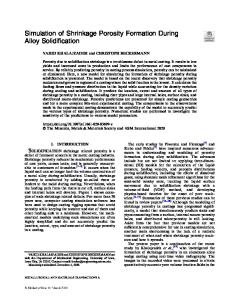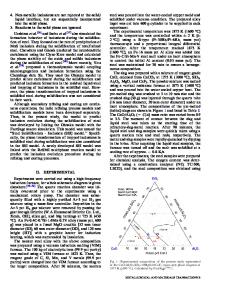Solidification Microstructure, Segregation, and Shrinkage of Fe-Mn-C Twinning-Induced Plasticity Steel by Simulation and
- PDF / 7,887,680 Bytes
- 21 Pages / 593.972 x 792 pts Page_size
- 7 Downloads / 401 Views
tention has been paid to high manganese austenite twinning-induced plasticity (TWIP) steel due to its extraordinary combination of high strength and high ductility, together with its excellent work hardening performance resulting from the formation of nanosized mechanical twins. A high product of strength and ductility was found in Fe-Mn-Si-Al TWIP steel by Grassel et al.,[1,2] Bru¨x et al.,[3] and Frommeyer et al.,[4] and the studies were extended by Vercammen et al.,[5,6] Saleh et al.,[7] Santos et al.,[8] Mi et al.,[9] Kriangyut Phiu-on et al.,[10] and Eskandari et al.[11] Although many difficulties have been found in casting, rolling, and coating processes, strip casting technology was developed for Fe-Mn-Si-Al TWIP steels in some laboratories and plants.[12,13] Another austenite TWIP steel, mainly in the Fe-Mn-C ternary system, was originally introduced by Hadfield with a composition range of 1.0 to 1.4 wt pct carbon and 10 to 14 wt pct manganese.[14–16] Unfortunately, Hadfield steels present very limited plasticity and
PENG LAN, Lecturer, HAIYAN TANG, Associate Professor, and JIAQUAN ZHANG, Professor, are with the School of Metallurgical and Ecological Engineering, University of Science and Technology Beijing, Beijing, People s Republic of China, 100083. Contact e-mail: [email protected] Manuscript submitted July 14, 2013. METALLURGICAL AND MATERIALS TRANSACTIONS A
weldability and are quite difficult to process.[17] New TWIP steels containing about 0.5 to 1.0 wt pct carbon and 15 to 30 wt pct manganese were developed recently to obtain an outstanding mechanical performance. A large amount of research on Fe-Mn-C ternary steel and Fe-Mn-Al-C quaternary steel was carried out by Kim et al.,[18–20] Han and Kim,[21] Hwang et al.,[22,23] Shun et al.,[24] Bouaziz and Guelton,[25] Dumay et al.,[26] Allain et al.,[27,28] Bracke et al.,[29,30] Ueji et al.,[31] Yoo et al.,[32] Jin and Lee,[33] and Koyama et al.[34,35] The delayed fracture was observed to be an important issue for the application of Fe-Mn-C TWIP steels, on which many specific experiments also were conducted.[36–41] Recently, twin roll strip casting was adopted to produce Fe-Mn-C or Fe-Mn-C-Al austenite TWIP steels.[42,43] It is well known that the casting process is of significant importance on steel product mechanical properties due to the heredity of solidification microstructure, shrinkage porosity, and segregation. However, a study focusing on the solidification characteristics of high-alloy TWIP steel is still lacking. In recent decades, solidification microstructure simulation technology has been rapidly developed. Saito et al.[44] and Damir[45] numerically studied the plate dendrite growth under steady conditions based on the front tracking method; Caginalp and Fife[46] and Kobayashi[47] built up an accurate description of the dendrite morphology using a phase field model, in which heat, flow, and solute transfer were fully coupled; Spittle and Brown[48] and Zhu and Smith[49] modeled the solidification grain
distribution in a two-dimensional domain using the
Data Loading...











